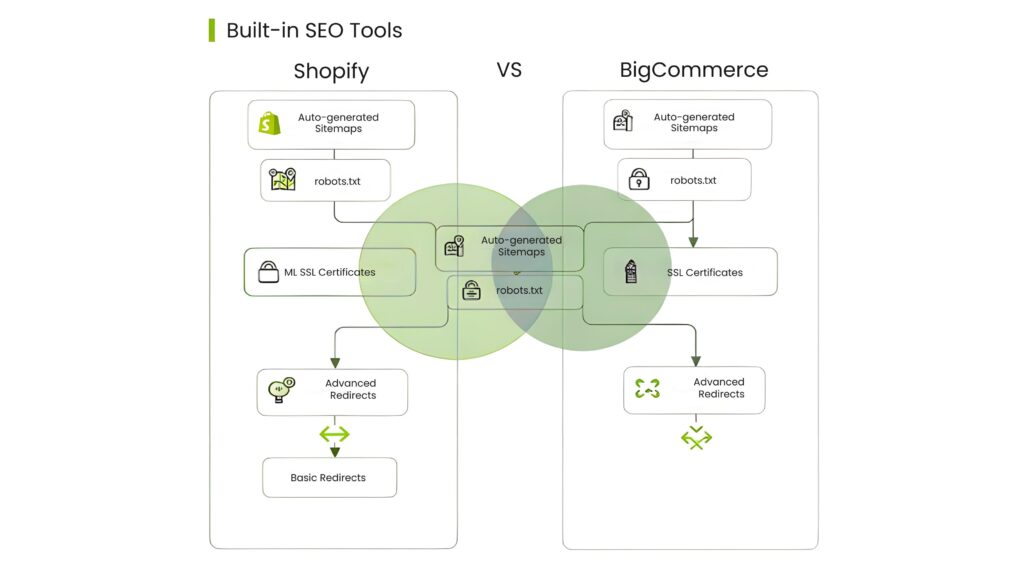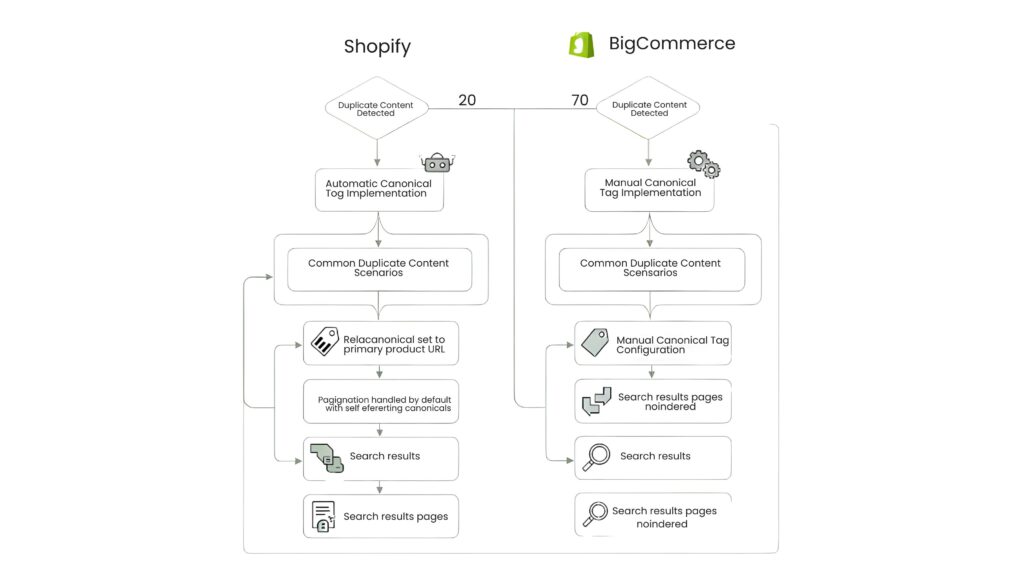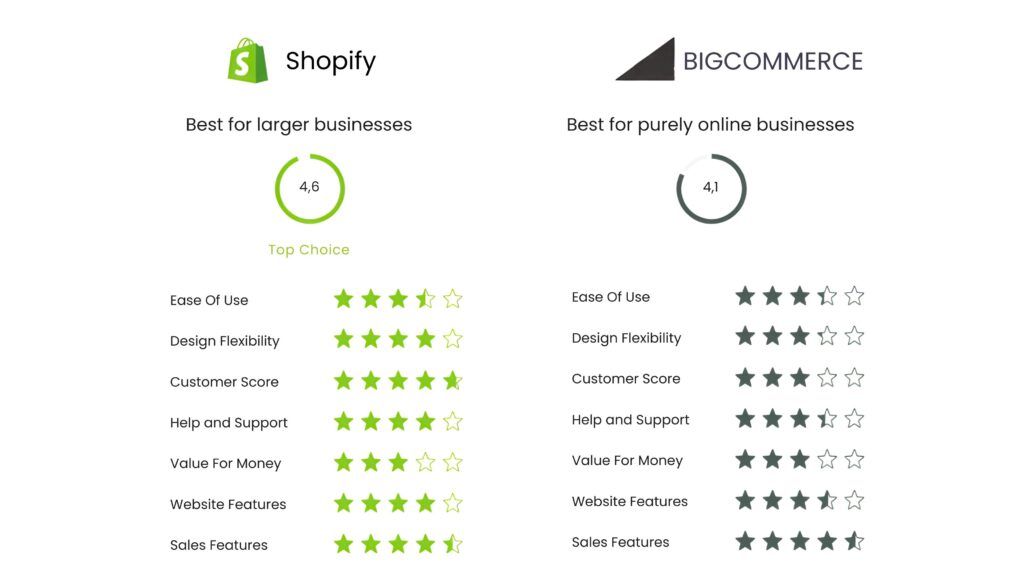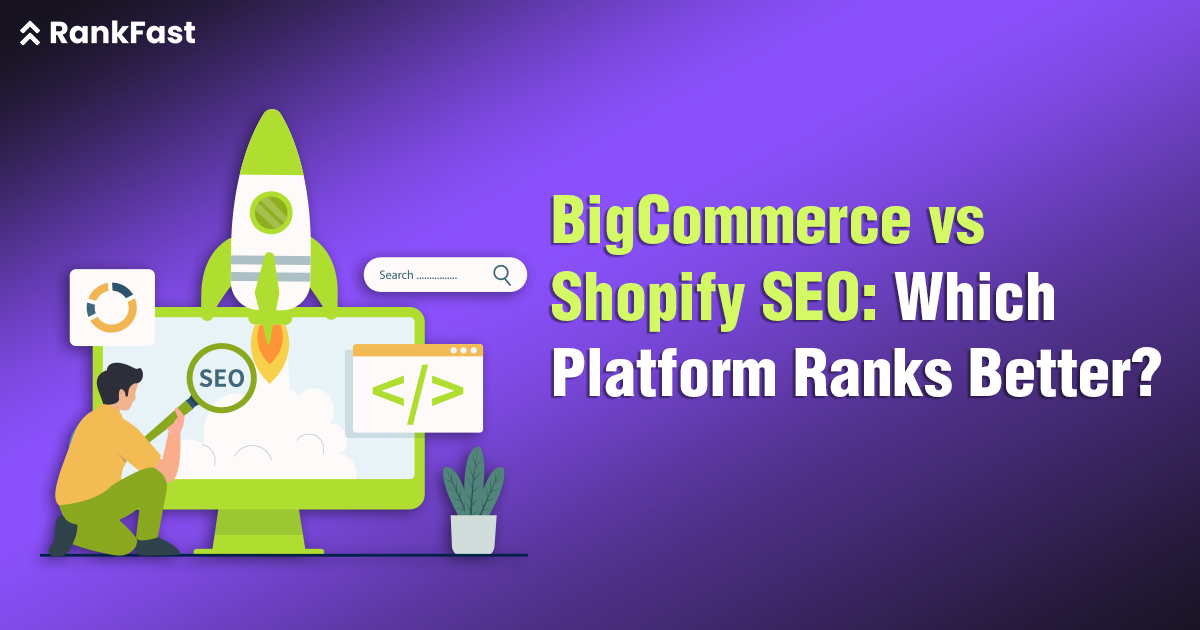When it comes to BigCommerce vs. Shopify SEO, choosing the right platform can dramatically impact your online store’s visibility. Shopify holds 10.32% of the global eCommerce software market share, generating over $7 billion in revenue and $3.5 billion in gross profit in 2023. Its market capitalization in 2024 is $96.35 billion. However, BigCommerce makes bold claims about its superior SEO features compared to Shopify.
While exploring Shopify vs. BigCommerce SEO capabilities, we’ve found some significant differences worth considering. In this comparison, we’ll break down exactly how these two e-commerce giants stack up for SEO, covering everything from technical capabilities to content optimization tools, so you can make an informed decision about which platform will help your products rank better.
BigCommerce vs Shopify SEO: Which Platform Ranks Better?
SEO Basics: How Shopify and BigCommerce Approach SEO
Built-in SEO Tools: Shopify vs BigCommerce
Default SEO Settings and Customization Options
Ease of Access to SEO Settings for Beginners
Meta Titles and Descriptions: Manual vs Automated Control
URL Structure: Shopify’s Fixed Paths vs BigCommerce Flexibility
Image Optimization and Alt Text Handling
Canonical Tags and Duplicate Content Management
AMP Support: Native vs App-Based Implementation
301 Redirects and Broken Link Handling
Robots.txt and Sitemap.xml Customization
Structured Data and Schema Markup Support
Content Marketing and Blogging Tools
Blog Functionality: Shopify vs BigCommerce
Content Localization and Multilingual SEO
SEO Plugins and App Ecosystem for Content Optimization
Page Speed: Mobile and Desktop Load Times
Mobile Responsiveness and Core Web Vitals
SEO Analytics and Reporting Tools
BigCommerce vs. Shopify: Pricing
Comparison Table: Shopify vs. BigCommerce
SEO Basics: How Shopify and BigCommerce Approach SEO
Search engine optimization stands as a crucial factor for e-commerce success, with research showing that 51% of web traffic comes from search engines, yet surprisingly, only 44% of businesses invest in SEO. Both Shopify and BigCommerce understand this importance and have developed different approaches to help store owners maximize their visibility.
Built-in SEO Tools: Shopify vs BigCommerce
First and foremost, both platforms offer essential SEO features that work automatically. Shopify provides auto-generated canonical tags, sitemap.xml, and robots.txt files, plus SSL certificates activated by default. Meanwhile, BigCommerce delivers customizable URL structures, meta tags, and header tags right out of the box.

The platforms differ significantly in how they handle technical SEO elements:
- Shopify excels with automatic sitemaps, structured data support, and seamless plugin integration through its user-friendly SEO dashboard
- BigCommerce offers more control with editable robots.txt files, wildcard redirects, and automatic breadcrumb generation
Notably, BigCommerce uses Akamai’s content delivery network to enhance site speed, a critical factor for both user experience and search rankings.
Default SEO Settings and Customization Options
In terms of default settings, Shopify automatically generates title tags that include your store name and handles many technical optimizations without user intervention. Furthermore, its themes are required to include social media linking options to enhance marketing efforts.
BigCommerce, in contrast to Shopify, offers more extensive customization capabilities. According to multiple sources, BigCommerce allows users to edit robots.txt files directly through the platform’s settings menu, whereas Shopify requires editing source code or using third-party apps for the same functionality.
For content marketing, BigCommerce enables businesses to leverage its blog feature for creating and publishing articles directly from the store. In essence, both platforms allow basic on-page SEO adjustments like title tags and meta descriptions, but BigCommerce generally provides deeper technical control.
Ease of Access to SEO Settings for Beginners
Shopify has earned a reputation for simplifying SEO tasks, especially for beginners. Its intuitive interface includes step-by-step guidance and user-friendly apps that make managing SEO settings straightforward. As a result, even those new to e-commerce can quickly learn to optimize their stores.
BigCommerce, while powerful, presents a steeper learning curve. The platform’s extensive options may initially overwhelm users who are new to SEO. Consequently, it might take longer to navigate and master all available settings.
For businesses without dedicated SEO expertise, Shopify’s built-in SEO settings make it easier to set up meta descriptions, page titles, and URLs. These elements come pre-written but can be customized to include target keywords for improved search engine rankings.
On-Page SEO Features Compared
The effectiveness of on-page SEO often determines whether your products appear on page one or page ten of search results. Both platforms offer distinct approaches to essential on-page elements that directly impact rankings.
Meta Titles and Descriptions: Manual vs Automated Control
Shopify provides more flexibility with meta content creation, allowing custom title tags and meta descriptions for all content types, including blog posts. The platform also features an AI meta tag creator to assist with generating optimized meta content.
BigCommerce, albeit powerful, has a notable limitation it automatically uses your blog post title as the title tag without allowing customization. For other pages, including products and categories, BigCommerce does permit custom meta titles and descriptions. Uniquely, Shopify offers custom excerpts for blog posts, a feature not natively available in BigCommerce.
URL Structure: Shopify’s Fixed Paths vs BigCommerce Flexibility
Perhaps the most significant on-page SEO difference between these platforms lies in URL structure control:
BigCommerce offers complete URL customization without forced prefixes, giving store owners full control over their URL architecture. This flexibility allows for shorter, cleaner URLs that potentially benefit SEO performance.
Shopify, conversely, imposes fixed URL paths that cannot be removed:
- Forces “/collections/” in category URLs
- Requires “/products/” in product URLs
- Creates double-nested blog URLs with “blog/blog-category/post-name” structure
This rigid structure makes Shopify URLs typically longer than necessary, which some SEO experts consider suboptimal.
Image Optimization and Alt Text Handling
Both platforms support alt text addition to images, primarily benefiting:
- Screen reader accessibility for visually impaired users
- SEO ranking potential through additional keyword context
- User experience when images fail to load
For optimal image SEO, both platforms recommend descriptive alt text under 125 characters. Particularly noteworthy, properly optimized alt text helped HubSpot increase image traffic by 779%, resulting in 160,000 additional organic views.
Canonical Tags and Duplicate Content Management
Duplicate content remains a common SEO challenge for e-commerce sites. Shopify automatically generates canonical tags to help search engines identify original content versions. Additionally, Shopify provides 301 redirects and customizable robots.txt files through apps.

BigCommerce users face challenges with canonical tag management, as the platform automatically self-canonicalizes every page without providing options to modify these tags. This limitation causes frustration among SEO-focused merchants who need to manage similar product pages without triggering duplicate content penalties.
Essentially, while both platforms address fundamental on-page SEO elements, BigCommerce generally offers more technical control except in the critical area of canonical tag management.
Technical SEO Capabilities
Technical underpinnings often make the difference between mediocre and exceptional SEO performance. Looking beyond basic on-page elements, both platforms offer distinct approaches to the more advanced aspects of search optimization.
AMP Support: Native vs App-Based Implementation:
BigCommerce provides native AMP (Accelerated Mobile Pages) support, which enhances mobile browsing speed and mobile SEO by delivering faster page loads. This built-in feature ensures seamless mobile performance without extra costs. In contrast, Shopify requires third-party apps to implement AMP, which adds complexity, potential costs, and limits some of the mobile SEO benefits.
301 Redirects and Broken Link Handling:
Shopify offers a straightforward 301 redirect system, allowing store owners to redirect old URLs to new ones, preserving SEO value. It includes bulk upload features through CSV for managing multiple redirects. BigCommerce provides a more flexible approach, with wildcard redirects allowing for simultaneous handling of multiple redirects, particularly useful during site migrations, preventing loss of SEO value.
Robots.txt and Sitemap.xml Customization:
BigCommerce offers complete control over robots.txt file editing, enabling store owners to fine-tune search engine crawling preferences directly through platform settings. Shopify now allows customization through the robots.txt.liquid template but had restrictions previously. Both platforms generate sitemap.xml files, but Shopify’s default settings may hinder indexing of key collection pages, potentially impacting SEO performance.
Structured Data and Schema Markup Support:
BigCommerce offers native schema markup support, making it easier to implement rich snippets, such as ratings and prices, directly within product listings. Shopify generates basic structured data automatically, but requires third-party apps for more complex features. BigCommerce’s built-in schema tools simplify technical SEO, while Shopify’s reliance on apps adds extra steps for advanced implementations.
Content Marketing and Blogging Tools
Beyond technical specifications, successful e-commerce stores need robust content marketing capabilities to drive organic traffic. Both Shopify and BigCommerce offer distinct approaches to blogging and content tools that significantly impact their SEO performance.
Blog Functionality: Shopify vs BigCommerce
Neither platform excels in native blogging capabilities. Shopify’s built-in blog lacks fundamental features such as image galleries, social sharing buttons, tagging systems, and native commenting functionality without third-party assistance.
BigCommerce tackles this limitation differently by enabling integration with external WordPress blogs. This approach gives BigCommerce users access to WordPress’s robust content management system without sacrificing their e-commerce functionality.
Content Localization and Multilingual SEO
For global businesses, multilingual capabilities are non-negotiable, given that English-only websites reach less than 25% of worldwide internet users. Shopify currently supports over 30 languages and facilitates translated storefronts that automatically redirect customers based on their browser’s language settings. In comparison, BigCommerce offers multi-currency features, allowing merchants to display, transact, and settle in various currencies.
Effective multilingual SEO requires more than simple translation. Indeed, CSA Research found that 40% of consumers will never purchase from brands that don’t speak their language. Subsequently, both platforms benefit from implementing hreflang tags, which signal to search engines which version of content is intended for specific audiences based on language and region.
SEO Plugins and App Ecosystem for Content Optimization
Regarding SEO app availability, Shopify holds a substantial advantage with approximately 640 SEO applications compared to BigCommerce’s mere 25. Furthermore, Shopify has integrated AI functionality through Shopify Magic, which includes features for theme generation, text creation, and an AI assistant that answers questions about store operations.
BigCommerce compensates for its smaller app ecosystem by including more built-in features that reduce dependency on third-party applications. Nevertheless, both platforms benefit from content optimization tools that help identify and add related keywords, improve readability, and update meta information.
Shopify maintains a slight edge in advanced SEO capabilities thanks to its comprehensive app ecosystem. For instance, Shopify partnered with Semrush to create the Ecommerce Booster app, providing detailed SEO plans with actionable recommendations.
Performance and SEO Impact
Page loading speed directly impacts not just user experience but search rankings as well. The difference between these platforms can significantly affect your store’s visibility and conversion rates.
Page Speed: Mobile and Desktop Load Times
In direct speed comparisons, Shopify loads considerably faster, averaging about 1.3 seconds compared to BigCommerce’s 2.6 seconds. This difference matters profoundly because when page load time increases from 1 second to 3 seconds, bounce rate probability jumps by 32%. For context, the average load time across top websites is 2.5 seconds on desktop and 8.6 seconds on mobile.
Mobile Responsiveness and Core Web Vitals
Google’s Core Web Vitals (CWV) have become crucial ranking factors that measure three key aspects of user experience:

- Largest Contentful Paint (LCP): How quickly meaningful content appears
- Cumulative Layout Shift (CLS): Visual stability during loading
- First Input Delay (FID): Responsiveness to user interaction
Currently, Shopify holds an advantage in CWV performance. Technology reports show Shopify has recently overtaken BigCommerce in the percentage of visitors experiencing good page experiences. Specifically, Shopify pages pass CLS tests nearly 60% of the time versus BigCommerce’s 40%.
SEO Analytics and Reporting Tools
Both platforms integrate with essential analytics tools, though with different approaches:
PageSpeed Insights helps identify specific performance issues by producing speed scores and actionable recommendations. Similarly, Google Search Console provides valuable insights into how search engines view your site, including Core Web Vitals reports showing real-world performance data.
Shopify has enhanced its analytics capabilities by including Google’s page speed metrics directly in each store’s admin dashboard, making performance monitoring more accessible to store owners without requiring third-party tools.
Comparison Table
| Feature Category | Shopify | BigCommerce |
| Market Position | 30% share of top million e-commerce sites, 73% of top 800 DTC brands | Not specified in the article |
| Built-in SEO Tools | • Auto-generated canonical tags• Automatic sitemap.xml• Default robots.txt files• SSL certificates by default | • Customizable URL structures• Editable meta tags• Header tags• Editable robots.txt files |
| URL Structure | • Fixed paths with forced prefixes• Required “/products/” and “/collections/”• Double-nested blog URLs | Complete URL customization without forced prefixes |
| Mobile Optimization | Requires third-party apps for AMP | Native AMP support for product and category pages |
| Language Support | Supports 30+ languages with automatic redirection | Multi-currency features available |
| Page Speed | Average 1.3-second load time | Average 2.6-second load time |
| Core Web Vitals | Passes CLS tests ~60% of the time | Passes CLS tests ~40% of the time |
| App Ecosystem | 640 SEO applications available | 25 SEO applications available |
| Meta Content Control | • Custom title tags• Custom meta descriptions• AI meta tag creator | • Limited blog title customization• Custom meta titles for products/categories |
| CDN Integration | Not specified in the article | Uses Akamai’s content delivery network |
| Canonical Tags | User-customizable canonical tags | Auto-generated, non-modifiable canonical tags |
| Redirect Management | Basic 301 redirect system with bulk upload | Advanced redirect system with wildcard options |
When choosing between BigCommerce and Shopify for SEO, understanding each platform’s strengths can significantly impact your online store’s search visibility and ranking potential.
BigCommerce vs. Shopify: Pricing
Both platforms offer a free trial BigCommerce offers 15 days, while Shopify gives 14 days. These trials allow you to assess which platform suits your business best before committing. Both platforms include unlimited products, file storage, bandwidth, and 24/7 customer support through phone and live chat.
BigCommerce Advantages
BigCommerce stands out by including advanced features even in its basic plans. These include professional reporting tools, a built-in ratings and reviews system, and real-time shipping rates. Additionally, BigCommerce allows unlimited staff accounts across all plans. However, there are sales limits: the Standard plan has a $50,000/year cap, and the Plus plan is limited to $180,000/year. Once these limits are exceeded, you must upgrade to a higher-tier plan.
Shopify’s Features
While Shopify lacks some of BigCommerce’s advanced features in lower-tier plans, it doesn’t impose sales limits, unlike BigCommerce. Additionally, all Shopify plans include an abandoned cart saver, a feature only available from the Plus plan upwards on BigCommerce.
Comparison Table: Shopify vs. BigCommerce
| Feature | BigCommerce | Shopify |
| Staff Accounts | Unlimited | 2 to 15 (depending on plan) |
| Transaction Fees | None | 0.5% to 2% (if not using Shopify Payments) |
| Reports | Professional reporting (all plans) | No reports on Basic plan |
| Abandoned Cart Recovery | Available on Plus and above | Available on all plans |
| Shipping Rates/Quotes | Available on all plans | Only on the Advanced plan |
| Ratings & Reviews | Available on all plans | Not available |
Cost Comparison
BigCommerce doesn’t charge transaction fees, unlike Shopify, which charges fees based on your plan and third-party payment processors. Shopify’s transaction fees range from 0.5% to 2%, which could add to your costs if you’re using third-party payment methods like PayPal or Stripe.
BigCommerce vs. Shopify Price Comparison Table
| BigCommerce | Shopify |
| Free 15-day trial | Free 14-day trial |
| Standard $29.95/mo | Basic Shopify $29/mo |
| Plus $79.95/mo | Standard Shopify $79/mo |
| Pro $299.95/mo | Advanced Shopify $299/mo |
| Enterprise (Contact Sales) | Shopify Plus (Contact Sales) |
| No transaction fees | Transaction fees apply |
| Unlimited staff accounts | Staff accounts limited |
BigCommerce wins in terms of pricing due to fewer charges, more built-in features, and unlimited staff accounts. Although Shopify’s plans allow unlimited sales, BigCommerce’s additional features and no transaction fees can result in lower overall costs, making it a more cost-effective choice for most businesses.
Why Choose Rankfast
When “BigCommerce vs. Shopify SEO” is on your mind, teaming up with the right agency is crucial. Here’s why Rankfast stands out:
- We are a leading BigCommerce SEO agency and Shopify SEO services provider, offering expertise tailored to your platform choice.
- With deep experience in technical SEO, content strategy, and global marketing, we’ve helped clients achieve double-digit growth in organic traffic and conversions.
- We deliver value—not fluff—focusing on measurable outcomes like speed, rankings, and revenue.
- Our integration capabilities span SEO, PPC (see our PPC for eCommerce offering), and content optimization—ensuring a cohesive strategy across paid and organic channels.
Final Thoughts
Both platforms can support effective SEO—but your choice depends on your priorities. If you want speed, usability, a wide app ecosystem, and international readiness, Shopify may serve you better. If you value deep technical control and built-in SEO features, BigCommerce might be the smarter base especially for complex or B2B setups.
But regardless of platform, SEO execution is vital—and that’s where Rankfast comes in. We combine strategic insight, technical proficiency, and proven workflows tailored to your platform—helping you outperform competitors, grow organic traffic, and improve conversions.
Ready to discover which platform lifts your SEO potential? Reach out to Rankfast for an in-depth audit and bespoke strategy for BigCommerce SEO services or Shopify SEO services. Your next phase of organic growth starts here.
FAQs
Q1. Which e-commerce platform offers better SEO features: Shopify or BigCommerce?
Both platforms have strong SEO capabilities, but they excel in different areas. Shopify offers better user-friendliness and performance metrics, while BigCommerce provides more technical control for advanced SEO strategies.
Q2. How do Shopify and BigCommerce compare in terms of page loading speed?
Shopify generally loads faster, with an average load time of 1.3 seconds compared to BigCommerce’s 2.6 seconds. This speed difference can significantly impact user experience and search rankings.
Q3. What are the main differences in URL structure between Shopify and BigCommerce? BigCommerce allows complete URL customization without forced prefixes, while Shopify imposes fixed URL paths that include “/products/” and “/collections/” in their respective URLs. This can affect SEO strategies and URL optimization.
Q4. How do the two platforms handle mobile optimization?
BigCommerce offers native Accelerated Mobile Pages (AMP) support for product and category pages, potentially improving mobile rankings. Shopify requires third-party applications to enable AMP functionality.
Q5. Which platform has a better app ecosystem for SEO?
Shopify has a significantly larger app ecosystem with approximately 640 SEO applications, compared to BigCommerce’s 25. This gives Shopify users more options for customizing and enhancing their SEO strategies.

Leave a Reply